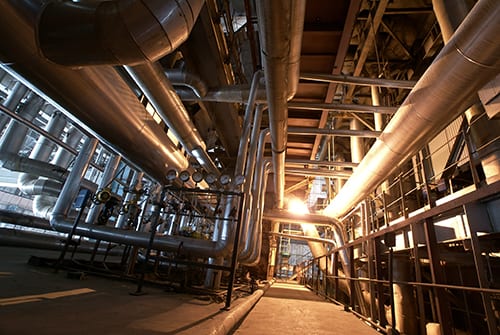Large industrial plants have a complex network of water piping that typically includes cooling water circuits, service water lines, high-purity makeup water system(s), and, often, multiple wastewater discharges. Up-to-date drawings and accurate water balances are vital for maintaining efficient operation, detecting abnormal water usage, and minimizing or preventing accidental discharge of potentially harmful waste streams.
Some examples we have seen include:
- An extended large loss of water from the raw water makeup at a plant. Portable ultrasonic flow testing allowed plant and contract personnel to identify the problematic circuit. The failed location was in a section of pipe located near a riverbank, so the leak was not visually evident.
- Accidental release of coal-pile runoff pond water into a surface supply through a normally isolated drain line. A backup isolation valve could have prevented this discharge.
- Significant condensate loss from a boiler feedwater system that supplied three steam generators. Ultrasonic flow testing of various circuits allowed the leak to be identified, saving the plant considerable money in makeup water production.
- A flow meter, portable or otherwise, that would have detected flow reduction in a neutralizing chemical feed line that suffered from gradual scale buildups due to the reaction of the neutralizing chemical with untreated raw water.
Many water lines at industrial plants are routed underground, which makes it imperative to develop accurate drawings during initial plant construction and update them when modifications are made. Far too often, plant and contract personnel only have outdated prints, if any, when planning a water or wastewater treatment modification. Outdated prints may greatly increase the hazards of excavation when installing new piping. Not infrequently, construction personnel have struck underground lines, water, gas, sewer or otherwise, that were not shown on any prints.
Comprehensive water balances are necessary to determine flow rates during full-load operation, but additional balances at off-design conditions are also valuable. Developing such balances can require substantial effort in identifying and tracing water lines. Many lines do not have permanent flow meters, but portable, ultrasonic flow measurements can often provide the accuracy needed to establish a good balance. Proper planning is needed when developing a balance to ensure conditions remain constant as readings are taken throughout the plant. This often requires coordination with system operators and plant management.
Another important flow metering location is cooling tower blowdown. Maximum output may be regulated by the plant’s discharge permit, but knowledge of the blowdown flow rate can be vital for maintaining proper chemistry within the tower. Many plants have their own industrial treatment facilities for handling the various waste streams, with sanitary waste in a separate network. Influent and effluent flow rates are important for adjusting treatment programs and tracking discharge.
ChemTreat can help you address challenges around water balance data. Please contact us for assistance in designing a treatment program customized for your application.
Like all other technologies, due diligence is necessary to determine the feasibility for utilizing methods. Always consult your equipment manuals and guides.

